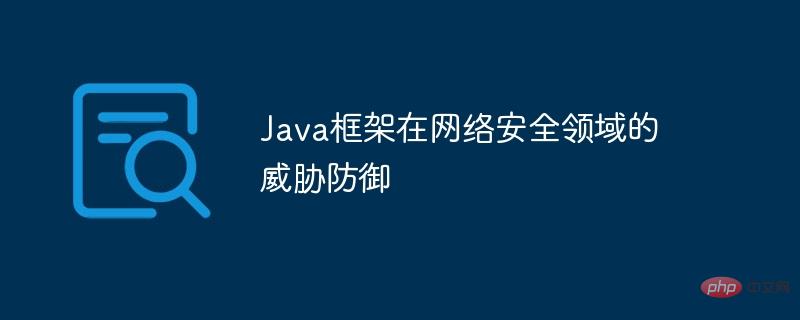
The Java framework provides built-in security features to effectively defend against cyber threats, including: Java Web Application Firewall to protect applications from common attacks. Vulnerability scanning tools identify potential security vulnerabilities. Authentication and authorization mechanisms to restrict access to resources. SQL injection defense mechanism to prevent malicious SQL queries. Practical cases show that Java frameworks can effectively protect websites from cyber attacks.

Threat defense of Java framework in the field of network security
Today, Java framework has become an indispensable part of network security , used to build a variety of security applications. By leveraging the built-in security features provided by Java frameworks, developers can effectively defend against cyber threats.
Java Web Application Firewall (WAF)
Java web application servers such as Apache Tomcat and Jetty provide built-in WAF that can protect applications from common attacks, such as:
// Apache Tomcat Web 应用防火墙配置
<Valve className="org.apache.catalina.valves.CSRFProtectionValve" />
<Valve className="org.apache.catalina.valves.RemoteAddrValve" />
// Jetty Web 应用防火墙配置
<Configure class="org.eclipse.jetty.webapp.WebAppContext">
<DisplayName>Secure App</DisplayName>
<SecurityHandler>
<CsrfProtectionHandler>
<WhiteListPaths>
<PathSpec>/index.html</PathSpec>
<PathSpec>/login.jsp</PathSpec>
</WhiteListPaths>
</CsrfProtectionHandler>
</SecurityHandler>
</Configure>Vulnerability Scanning
Java frameworks such as Spring Security and OWASP ZAP provide vulnerability scanning tools that can identify potential security vulnerabilities in applications:
// Spring Security 漏洞扫描
ApplicationContext context = new ClassPathXmlApplicationContext("applicationContext.xml");
SecurityContext context = (SecurityContext) context.getBean("securityContext");
User user = (User) context.getAuthentication().getPrincipal();
// OWASP ZAP 漏洞扫描
OWASPZapClient client = new OWASPZapClient("localhost", 8090);
client.scan("http://localhost:8080", "myApplication");Authentication and Authorization
Shiro, Spring Security and other Java frameworks provide authentication and authorization mechanisms to restrict access to resources:
// Shiro 配置
<securityManager>
<authenticator>
<simpleAccountRealm>
<user>admin</user>
<password>password</password>
<roles>admin</roles>
</simpleAccountRealm>
</authenticator>
</securityManager>
// Spring Security 配置
@Configuration
@EnableWebSecurity
public class WebSecurityConfig extends WebSecurityConfigurerAdapter {
@Override
protected void configure(HttpSecurity http) throws Exception {
http
.authorizeRequests()
.antMatchers("/admin").hasRole("ADMIN")
.anyRequest().authenticated()
.and()
.formLogin();
}
}SQL injection defense
Java framework provides SQL injection protection mechanism to prevent malicious SQL queries:
// Hibernate 配置
@Entity
@Table(name="users")
public class User {
@Id
private Long id;
@Column(name="username", nullable=false, length=100)
private String username;
// ...
}
// Spring Data JPA 查询示例
User user = userRepository.findByUsername("john");Practical case
An e-commerce website uses Spring Security framework protection its website. By configuring Shiro to prevent CSRF attacks and using Hibernate for SQL injection protection, the website is effectively protected against a variety of cyber threats.
Conclusion
The Java framework provides rich security features that enable developers to build secure web applications. By leveraging these capabilities, organizations can effectively protect their systems from cyberattacks.
The above is the detailed content of Threat defense of Java framework in the field of network security. For more information, please follow other related articles on the PHP Chinese website!